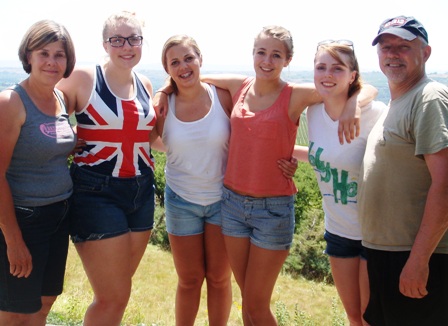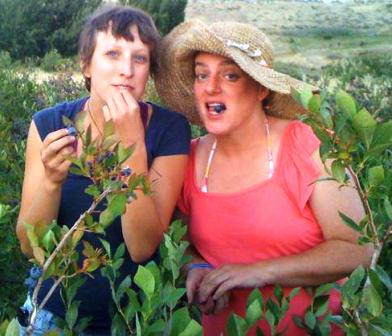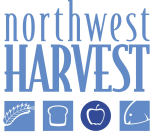Dealing with Overabundance
 Yakima County is first in the nation for number of fruit trees. The region produces more apples, mint, winter pears, and hops than any other county in the US; other major crops include cherries, apricots, peaches, beef, wheat, and wine. In a region with such a large scale of agricultural abundance, it is easy to get overwhelmed with the amount of produce available for gleaning. For most gleaning opportunities, our program is anywhere from slightly to vastly under-resourced with volunteers to glean all the produce available.
Yakima County is first in the nation for number of fruit trees. The region produces more apples, mint, winter pears, and hops than any other county in the US; other major crops include cherries, apricots, peaches, beef, wheat, and wine. In a region with such a large scale of agricultural abundance, it is easy to get overwhelmed with the amount of produce available for gleaning. For most gleaning opportunities, our program is anywhere from slightly to vastly under-resourced with volunteers to glean all the produce available.
With so much produce available, it is important to pick and choose gleaning opportunities based on available volunteer resources and based on whether or not that opportunity strengthens your organization’s relationship with a grower or the community of growers in your area. For example, our gleaning program might pass up 20 acres of cherries from a commercial producer who is a new donor but say yes to 20 acres of cherries from an existing cull donor. While our gleaning program will probably only be able to pick 1 or 2 acres of each, the second opportunity strengthens a donor relationship, which makes it worth the effort and possible frustration.
In addition, it is important to be honest with producers about your program’s volunteer resources and to create relationships that will continue year after year. That way, if you can’t find volunteers to take advantage of the opportunity this year, the producer trusts that you will pick more of that produce the next year as you plan ahead and spread the word further in advance.
Keeping Up with Market Trends
Northwest Harvest’s Yakima warehouse subscribes to Good Fruit Grower to stay aware of fruit industry trends so that our program knows what to expect during the growing season and is better able to relate to growers. Engaging the growers you work with to find out issues their industry struggles with can also be beneficial to your donor relations. For example, our program may chose to ask a producer who grows cherries and apples for access to only their cherries this year, since apple prices are high. The apples that they would normally offer to our gleaners, because they are unmarketable (hail-damaged, small), will sell for a great juice price, making it worthwhile for the farmer to keep and sell them. Or our program may chose to approach organic farms for their Farmers Market leftovers instead of their orchard fruit, since the price for seconds in organic fruit is relatively high. Similarly, our program tries to recognize labor shortages and may chose not to ask the apple grower with apples still hanging on the tree for gleaning opportunities, since that grower is looking for pickers and having volunteers pick marketable fruit is salt in that wound. Knowledge of the issues facing farmers helps facilitate trust between gleaners and growers and helps you avoid any faux pas.
Leveraging Your Purchasing
One of the most important lessons that our gleaning program learned during the 2012 season is that a little bit of purchasing goes a long way! Purchasing some produce from a commercial grower can open the floodgates for gleaning or outright donations. At our Farmers Market booth (see “Farmers Market Donations” section), purchasing $200 worth of peaches from one grower yielded almost $2,000 worth of donated peaches and apples! Similarly, purchasing from a large vegetable grower increased his cull bin donations to Northwest Harvest and yielded a couple of large gleaning opportunities. If a food bank or gleaning program has the funds to purchase some product, they should use that purchasing to strengthen a relationship with an existing donor or to recruit a new donor to their program.
Staying Organized: Make a Calendar!
To keep track of which grower is which, when their crop will be ready, and what crops they grow, the gleaning program in Yakima uses a calendar such as the one below. This calendar includes the name of the farm, which months they will have crops available, and what those crops are. Because the gleaning program in Yakima has lots of different programs for donors (e.g. Farmers Market, field gleaning, cull bin gleaning), the calendar is also color coded to show which programs a grower is involved with at a glance. In addition to aiding donor relations, a calendar is also useful for advance volunteer recruitment. For those who find visuals more helpful than spreadsheets, a calendar is a great tool!
Important Questions
The gleaning program in Yakima uses this donor information form to make sure to ask all of the important questions. Also, when time permits, a site visit can answer most questions and give the gleaning coordinator a better idea of the flow of a gleaning event and how much produce will be available. Our program also uses the satellite and Earth functions of Google Maps to scope a site before a glean if a site visit is not possible. Google Maps is especially helpful when using a large truck so that drivers know where to pull, park, and back up and which sections are gravel, dirt, and pavement.
Answer growers’ questions, concerns and liability issues upfront and as honestly as possible. Be able to explain the Bill Emerson Good Samaritan Food Donation Act and Release of Liability and Waiver of Damages Form. Liability is a legitimate concern, and should be handled carefully. Preface the conversation by saying you understand and respect the grower’s concerns, and have a focused and accurate explanation of the act and form as a tool while talking to growers.
When on the phone with a producer, be direct: ask the producer what they need from you, and how you can make things easiest for them. Another tip when on the phone is to smile. People can hear that through the phone, and might help you and the producer to have a relaxed and productive conversation.
When working with producers, be as flexible as possible. Every producer is different and has their own unique way of doing things. They are taking time out of their day to help you, so coordinating gleaning events around their schedule is extremely important.
 Producers and Media
Producers and Media
Inviting media to a gleaning event is a great way to spread the word about your program. However, be sure to mention the opportunity of news coverage to the producer before disclosing the address of the gleaning event or agreeing to the reporter’s request to record the event. Make sure that the producer is comfortable with someone from the media on their property. Also, ask the producer if they would like to remain anonymous and ensure that there are no specifics about their location. Disclosing a producer’s name or location can make them a target for crime, especially in remote, rural areas. When the reporter arrives at the site take a moment to mention details that need to be excluded as requested by the grower. Reporters typically respect these requests as long as they know about them ahead of time.
Appreciation
Be sure to get a mailing address or email at some point before the gleaning event ends. Some producers ask for a receipt, and mailing or emailing it is a great way to take the pressure off while in the field. This gives the gleaning program an opportunity for the organization to get the correct weight and the receipt together without being rushed. Mailing the receipt with a hand written thank you letter is a nice way to say thank you one more time - even though you have probably thanked them already.

 Yakima County is first in the nation for number of fruit trees. The region produces more apples, mint, winter pears, and hops than any other county in the US; other major crops include cherries, apricots, peaches, beef, wheat, and wine. In a region with such a large scale of agricultural abundance, it is easy to get overwhelmed with the amount of produce available for gleaning. For most gleaning opportunities, our program is anywhere from slightly to vastly under-resourced with volunteers to glean all the produce available.
Yakima County is first in the nation for number of fruit trees. The region produces more apples, mint, winter pears, and hops than any other county in the US; other major crops include cherries, apricots, peaches, beef, wheat, and wine. In a region with such a large scale of agricultural abundance, it is easy to get overwhelmed with the amount of produce available for gleaning. For most gleaning opportunities, our program is anywhere from slightly to vastly under-resourced with volunteers to glean all the produce available.  Producers and Media
Producers and Media